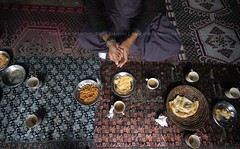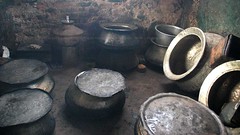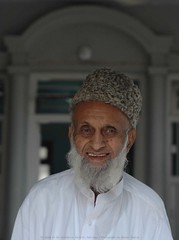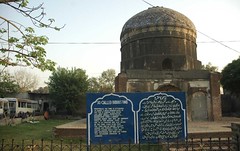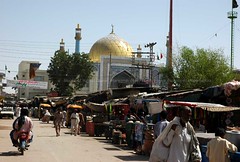This series was intended to end at Darkot Pass or even further the hill. But unfortunately this was not to happen. Our trek was cut short due to cold weather, heavy rainfall but most importantly, due to seriously flawed leadership. Therefore, this blog series will serve only as a reminder of that trip (from 9th Sep, 2011 to 24th Sep, 2011).
Breakfast while on our way to Gilgit from Rawalpindi via Babusar pass. This surely is one of the finest places in Pakistan and the breakfast was fair enough. I really enjoyed the parathas and the chai but not the choola.
Tuesday, September 27, 2011
Thursday, September 8, 2011
Chowkandi Tombs, Sindh
Via Flickr:
The Chaukhandi (Urdu: چوکنڈی) tombs are situated 29 km (18 mi) east of Karachi on N-5 National Highway near Landhi Town in Pakistan. The Chaukhandi tombs are remarkable for the elaborate and exquisite stone carving.
The style of architecture is typical only to the region of Sindh, and unique in that it is found nowhere else in the Islamic world. Generally, the elements are attributed to Jokhio (also spelt Jokhiya) also known as the family graveyard of Jokhio tribe, some people of Baluch tribe also buried were built between the 15th and 18th centuries.
Further reading:
en.wikipedia.org/wiki/Chaukhandi_tombs
The Chaukhandi (Urdu: چوکنڈی) tombs are situated 29 km (18 mi) east of Karachi on N-5 National Highway near Landhi Town in Pakistan. The Chaukhandi tombs are remarkable for the elaborate and exquisite stone carving.
The style of architecture is typical only to the region of Sindh, and unique in that it is found nowhere else in the Islamic world. Generally, the elements are attributed to Jokhio (also spelt Jokhiya) also known as the family graveyard of Jokhio tribe, some people of Baluch tribe also buried were built between the 15th and 18th centuries.
Further reading:
en.wikipedia.org/wiki/Chaukhandi_tombs
Wednesday, September 7, 2011
Langhar deghs at Shrine of Shah Yaqiq, Sindh
Via Flickr:
All shrines across Pakistan feed poor people. This general feeding is known as Langhar and the place where the food is cooked is known locally as 'Langhar Khana'. Thousands of people are fed daily at each of the major Shrine of Pakistan. This helps greatly in a country where food may be expensive for quite a lot of people.
Here, the empty deghs (in which food is cooked) are waiting for the food to arrive at the Sufi Shrine of Hazrat Shah Yaqiq (RA).
All shrines across Pakistan feed poor people. This general feeding is known as Langhar and the place where the food is cooked is known locally as 'Langhar Khana'. Thousands of people are fed daily at each of the major Shrine of Pakistan. This helps greatly in a country where food may be expensive for quite a lot of people.
Here, the empty deghs (in which food is cooked) are waiting for the food to arrive at the Sufi Shrine of Hazrat Shah Yaqiq (RA).
Monday, September 5, 2011
Eid-ul-Fitr mehndi, Karachi
My sister's Eid mehndi. This itself is an art form. Charges: Rs.400.
Labels:
celebration,
celebrations,
girl,
henna,
mehndi,
Pakistani
Thursday, September 1, 2011
My dada on Eid-ul-Fitr, Karachi
Via Flickr:
Dada is an Urdu term meaning 'Paternal grandfather'. My dada's name is Haji Moosa Adhia, Adhia being the family name. My dada and dadi came from India after it was partitioned into Pakistan and India in 1948 via ship. So they were spared the troubles faced by people arriving by trains at Lahore via Amritsar. I often ask my dada about the hardships he faced while coming here but he always tells me it was difficult to leave his ancestral home. But he never recalls any problem arising on the ship itself, which sailed from Bombay to Karachi.
My dada hails from a small Indian town of Bhawannagar, Gujerat province.
Dada is an Urdu term meaning 'Paternal grandfather'. My dada's name is Haji Moosa Adhia, Adhia being the family name. My dada and dadi came from India after it was partitioned into Pakistan and India in 1948 via ship. So they were spared the troubles faced by people arriving by trains at Lahore via Amritsar. I often ask my dada about the hardships he faced while coming here but he always tells me it was difficult to leave his ancestral home. But he never recalls any problem arising on the ship itself, which sailed from Bombay to Karachi.
My dada hails from a small Indian town of Bhawannagar, Gujerat province.
Buddu tomb, Lahore
One of the numerous historical sites found in Lahore. I love Lahore and I love the fact that it has 1000-year worth of historical places, many of which were delibrately destroyed by the British post-1857 clean-up operation. Many more have been destroyed by land mafia and exploding population of the metropolis. How sad that we cannot preserve our brilliant historical buildings and parks.
Leftover tandoor bread, Sehwan Sharif, Sindh
Waiters have collected leftover and badly cooked unleavened breads (known as Tandoor ki roti in Pakistan or naan) in a metal tub. These are either sold to rag picker or given for free to poor and the needy. Atleast its not wasted. But many dhabas (an Urdu term for local, roadside restaurants) just waste such breads and other food items.
Shrine of Hazrat Usman Marwandi (RA), Sindh
This is the back street of the Sufi shrine / Mazar of Hazrat Usman Marwandi (RA) more popularly known as Lal Shahbaz Qalandar. This is the new building and the actual historical building was destroyed to make way for this copy cat structure. Unfortunate as it may sound, history has no place in Pakistan. And one by one, we are loosing buildings which are impossible to reconstruct.
Subscribe to:
Posts (Atom)
